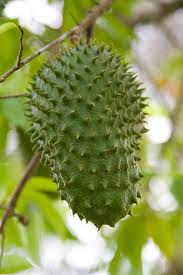This amazing fruit has a lot of names.
In Spanish guanábana, Portuguese, graviola, in Brazilian pawpaw, guyabano, corossolier, guanavana, toge-banreisi, durian benggala, nangka blanda, and nangka londa. In Malayamalam it is called "Mullaatha" , literally thorny custard apple.The other lesser known indian names are,"Shul-Ram-fal" and "Hanuman fal".
In English it is called soursop (Annona muricata). It is a broadleaf flowering evergreen tree native to Central America, the Carribean and northern South America, Columbia and Brazil, Mexico,Peru,Venezuela, Soursop is also native to sub-Saharan African countries that lie within the tropics. Today, it is also grown in some areas of Southeast Asia. It was most likely brought from Mexico to the Philippines by way of the Manila-Acapulco galleon trade. It is now cultivated in all parts of the Archipelago.
Called guyabano, or babana or sikopana in the Philippines, it is a small tree about 5 to 7 meters in height. The leaves are alternate, oval in shape, pointed at both ends, smooth and shining, 7 to 20 centimeters long and with petioles about 5 millimeters long. The flowers are large, yellowish or greenish yellow and solitary. There are six large, fleshy or leathery petals in two series. They are heart-shaped, with pointed tip, and up to 5 centimeters in length and 3 centimeters in breadth. In the center of the flower is a cone-shaped mass of many carpels which will form the fruit, and below this are very numerous stamens.
Guyabano is a green, soft spine, pea-shaped fruit with a sweet-sour flavor. It weighs about two to five kilos. The skin is thin and its flesh is a white, soft fibrous pulp which has a very agreeable flavor but rather sour. Its mature, green fruit is used as vegetable and made into sweet meats, while the ripe fruit is eaten raw or for dessert.
Its flavor has been described as a combination of strawberry and pineapple with sour citrus flavor notes contrasting with an underlying creamy flavor reminiscent of coconut or banana..A lot of concoctions can be made into guyabano like delicious sherbets, ice drops and fruit drinks. An assortment of punch and cocktail drinks can be made by mixing the nectar with wine rum or cola drinks or buko (fresh coconut) juice and ice.
There are two strains of guyabano: the sweet and the ordinary. Both have the same botanic description. The former, however, tastes sweeter than the ordinary. Belonging to the family Anonaceae, other familiar fruits beside guyabano are atis (Anona Squamosa or sugar apple), anonas (Anona reticulata or custard apple), and atemoya (Anona).

No comments:
Post a Comment